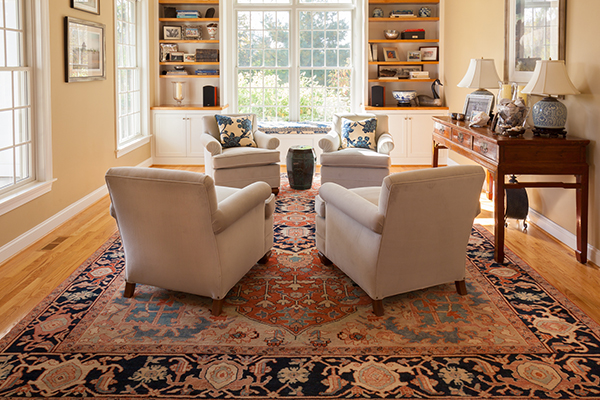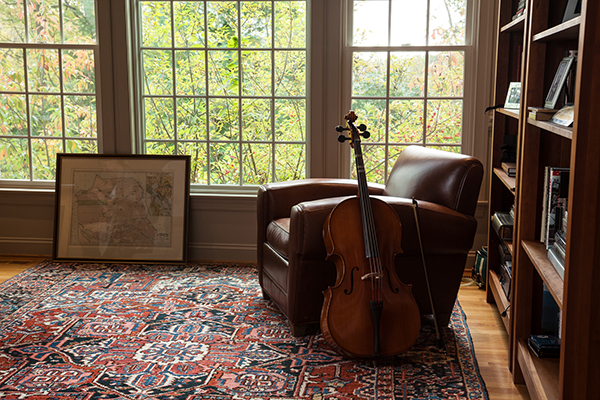
Incorporating Oriental Rugs into your Interior Designs
Browse through fifty years of Architectural Digest, and you will find that Oriental rugs are featured in at least one home in every issue. In fact, Oriental rugs have been prized in Western interiors since the 16th century. Why? Because they make rooms look wonderful, and they do it instantly, without any trouble at all. Besides that, they’re practical. They’re easy to care for and they last for decades.
Designing with Oriental rugs is surprisingly easy. Essentially it’s a matter of trying rugs at home until you find one that looks great. One needn’t be an expert to judge what looks good, and, in fact, the most important thing is to find a rug or carpet that you really love.
 1. If possible, start with the Oriental rug.
1. If possible, start with the Oriental rug.
A hundred and fifty years ago, Edger Allen Poe wrote that “the soul of the apartment is the carpet.” He meant that the carpet is the foundation of the décor, and all else flows from it. The moment you choose carpets for a room, you establish how the room will be laid out—into one large space, for instance, or, using several smaller rugs, into discrete areas such as the space before the fireplace or the area behind the sofa. Secondly, when you choose the rug or rugs for a room, you establish the colors that will look good in it. It is far easier to buy furniture and fabric to complement the carpet than the other way around.
Emmett Eiland’s Oriental Rug Company can help make it easy to choose furniture and fabric to match your carpet by providing you with a free 8 by 10 professional photograph of any carpet you buy from us. Take the photo with you for reference when you are shopping for furniture.
2. Using this website is a good way to get started.
On it you can easily familiarize yourself with the styles of Oriental rugs that are available, their cost and so forth. You will be able to search by many parameters simultaneously. For instance, you may want to do a search for new rugs between 9 and 10 ft wide by 12 to 13 ft long, with natural dyes, formal designs and blue fields. Or nearly anything else.
Keep in mind that not all of Emmett Eiland’s collection is online. To see everything in stock, visit the store in Berkeley. Eventually you will want to try rugs at home on an approval basis. Rug dealers expect it.
 3. Determine the right size of the carpet you will need for the room.
3. Determine the right size of the carpet you will need for the room.
Usually there is no harm in having the front legs of a chair or sofa on the rug and the back legs off.
You most likely will want to allow for a border of hardwood floor or of carpeting (or marble or whatever your floor is made of) to show on all sides of the carpet. So, for instance, if the space in which you would like a rug is 12 feet by 16 feet, you might select a carpet that is 9 by 12 feet, thus allowing for one and a half or two feet of border all the way around the carpet—with less space around a smaller rug.
In any case, don’t be too rigid about the size you require. Many people make the process of finding a rug almost impossible by hitting on an exact size and insisting on it. If you can, come up with a range of sizes that are possible. You will vastly increase the number of rugs from which to choose. Consider, for instance, that ordinarily there is no harm in having the front legs of a chair on a carpet and the rear legs off. Being flexible about size may mean the difference between winding up with a carpet that “works,” and one that you really love.
The classic Oriental rug sizes are:
- 3.5 ft x 5 ft
- 4 ft x 6 ft
- 5 ft x 7 or 8 ft
- 6 ft x 9 ft
- 8 ft x 10 ft
- 9 ft x 12 ft
- 10 ft x 14 ft
- 12 ft x 15 ft
- 12 ft x 18 ft
4. People buy Oriental rugs on the basis of color, and rightly so.
Having the right colors in a room is absolutely critical. But who is to say which are the right colors? Well, you are. On the basis of our experience, do-it-yourself designers are remarkably sophisticated in choosing colors. In any case, you will have the opportunity to take rugs home on an approval basis, making the whole process of choosing colors a lot less abstract If possible, when you visit a showroom, bring swatches of fabric from upholstery or drapes. Not only will that help you, but it will help your salesman know what to show you.
Keep this in mind: Dark colors in a carpet bring the ceiling down. Light colors make the ceiling seem higher.
Designing with Oriental Rugs Pic 4
5. Oriental Rug Design
There are thousands of Oriental rug designs, but basically they fall into the following groups, each of which will influence the design of your interior.
- Designs with straight lines and geometric figures. These designs suggest country origins and may even have a kind of Navajo rug feeling. Designs like this are useful informal interiors such as a south-west look, for instance, or an arts-and-crafts look.
- Designs with curvilinear lines. These are associated with carpets of a city manufacture and are useful in more formal settings such as a European-inspired interior.
- Contemporary designs. These may run from abstract to single-color rugs, but one thing they have in common is that they often are appropriate in modern and contemporary interiors.
Beyond these broad categories, you will find designs that are based on medallions, others that are all-over, a few that are pictorial, some that are directional, and others that are organized into panels. Each has a different effect in a room. For instance, a rug with a central medallion usually is placed so that the medallion falls in the middle of something, so to speak—under a chandelier, for instance, or in the middle of an area or room or under the middle of a table.
Another distinction you may make is between small-scale and large-scale designs. It may be said that small scale designs call attention to the furniture on them, while carpets with large-scale, dramatic designs call more attention to themselves and become an important focal point in the interior.
In the end, though, in this matter of carpet design you may wish to be guided simply by what you like. Many people, for instance, prefer rugs with central medallions. If it so happens that the medallion doesn’t line up with some other interior feature, it is no great tragedy. The most important thing about interior design, in our opinion, is to love the final outcome and to be delighted by the objects with which you have surrounded yourself.
The above article is an excerpt of an article originally published at internetrugs.com

